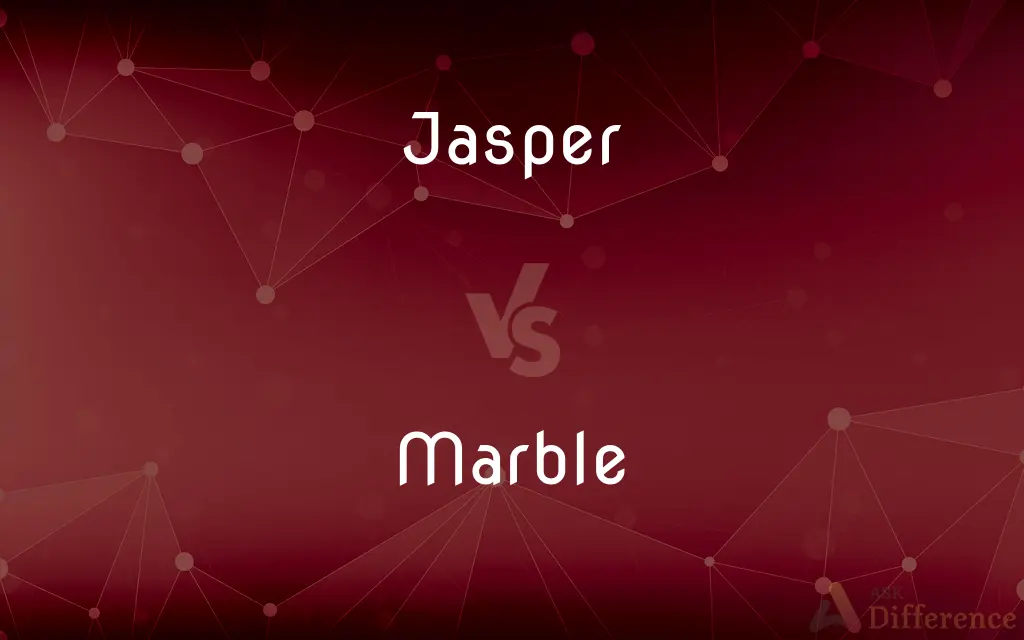Jasper vs. Marble — What's the Difference?
By Maham Liaqat & Fiza Rafique — Updated on March 28, 2024
Jasper is a microcrystalline quartz known for its opacity and grainy texture, often used in jewelry, while marble is a metamorphic rock with a smooth texture, prized in sculpture and architecture for its beauty and workability.

Difference Between Jasper and Marble
Table of Contents
ADVERTISEMENT
Key Differences
Jasper, a form of chalcedony, is distinguished by its opacity and fine-grained structure. It comes in a variety of colors, often featuring intricate patterns or banding, which makes each piece unique. This mineral is primarily used in jewelry making and ornamental art, valued for its earthy beauty and durability. On the other hand, marble is a metamorphic rock formed from the recrystallization of limestone. It is characterized by its smooth texture and veined patterns, resulting from impurities in the original limestone. Marble's aesthetic appeal and ease of carving have made it a favored material for sculptures, architectural elements, and a variety of decorative arts.
Jasper's hardness and resistance to weathering make it suitable for outdoor applications, including garden ornaments and facades. Its dense, grainy texture not only contributes to its distinctive appearance but also to its strength and durability. Marble, while also durable, is more susceptible to acid rain and general wear, requiring more maintenance when used outdoors. Its translucence can give depth and life to sculptures and buildings, a quality not found in the opaque jasper.
In terms of processing, jasper can be polished to a high shine, highlighting its colors and patterns, making it ideal for jewelry such as pendants, beads, and cabochons. Marble's workability, however, allows it to be shaped into intricate designs, polished for a high gloss finish, or left matte to suit different artistic and architectural styles.
Culturally, both stones have significant histories. Jasper has been used since ancient times for its protective and healing properties, featured in jewelry and amulets. Marble has a storied past in architecture and sculpture, symbolizing purity and immortality, notably used in ancient Greek and Roman works, and continuing to hold prestige in modern design.
The choice between jasper and marble often depends on the application. Jasper's toughness and unique aesthetic make it preferred for personal adornment and small-scale decorative items. Marble, with its elegant veins and softness, is sought after for large-scale projects like buildings, monuments, and statues, where its beauty can be showcased on a grand scale.
ADVERTISEMENT
Comparison Chart
Composition
Microcrystalline quartz
Metamorphic rock (recrystallized limestone)
Texture
Opaque and grainy
Smooth and often veined
Durability
High, resistant to weathering
Susceptible to acid, requires maintenance
Usage
Jewelry, ornamental art
Sculpture, architecture, decorative arts
Workability
Polished to a high shine
Can be shaped intricately, polished to high gloss
Cultural Significance
Ancient symbolism for protection
Symbolizes purity, used historically in significant architecture and art
Maintenance
Low maintenance required
High maintenance, especially outdoors
Aesthetic
Earthy, with varied colors and patterns
Elegant, with translucent quality and veins
Compare with Definitions
Jasper
A form of chalcedony known for its opacity and grainy texture.
The bracelet was adorned with red jasper stones, each showcasing unique patterns.
Marble
A metamorphic rock formed from limestone, characterized by its veined and smooth texture.
The lobby featured walls clad in exquisite white marble.
Jasper
Often used in jewelry and decorative items for its durability and beauty.
The artist chose jasper for the sculpture to utilize its natural earth tones.
Marble
Requires more maintenance when used outdoors due to susceptibility to wear.
The marble statue in the garden needed regular cleaning to preserve its beauty.
Jasper
Can be polished to highlight its intricate patterns and colors.
Polished jasper beads were selected for the necklace to bring out their vibrant hues.
Marble
Known for its aesthetic appeal in both historical and modern design.
Modern homes often use marble countertops for their timeless elegance.
Jasper
Recognized for its protective qualities in ancient cultures.
Ancient warriors wore jasper amulets for strength and protection.
Marble
Symbolizes purity and immortality, especially in classical art.
Marble has been used throughout history to create statues and monuments that stand the test of time.
Jasper
Found in a variety of colors, often with banding or patterns.
The jasper stone exhibited a beautiful landscape pattern, reminiscent of a desert scene.
Marble
Prized in sculpture and architecture for its beauty and workability.
The sculptor chose marble for its ability to be finely detailed.
Jasper
Jasper, an aggregate of microgranular quartz and/or chalcedony and other mineral phases, is an opaque, impure variety of silica, usually red, yellow, brown or green in color; and rarely blue. The common red color is due to iron(III) inclusions.
Marble
Marble is a metamorphic rock composed of recrystallized carbonate minerals, most commonly calcite or dolomite. Marble is typically not foliated, although there are exceptions.
Jasper
An opaque cryptocrystalline variety of quartz that may be red, yellow, or brown.
Marble
A metamorphic rock formed by alteration of limestone or dolomite, often irregularly colored by impurities, and used especially in architecture and sculpture.
Jasper
(obsolete) Any bright-coloured kind of chalcedony apart from cornelian.
Marble
A piece of this rock.
Jasper
An opaque, impure variety of quartz, of red, yellow, and other dull colors, breaking conchoidally with a smooth surface.
Marble
A sculpture made from this rock.
Jasper
Jasperware pottery.
Marble
Something resembling or suggesting metamorphic rock, as in being very hard, smooth, or cold
A heart of marble.
A brow of marble.
Jasper
A wasp.
Marble
A small hard ball, usually of glass, used in children's games.
Jasper
A person, a guy, especially seen as naïve or simple.
Marble
Marbles (used with a sing. verb) Any of various games played with marbles.
Jasper
(transitive) To decorate with, or as if with, jasper.
Marble
Marbles Slang Common sense; sanity
Completely lost his marbles after the stock market crash.
Jasper
An opaque, impure variety of quartz, of red, yellow, and other dull colors, breaking with a smooth surface. It admits of a high polish, and is used for vases, seals, snuff boxes, etc. When the colors are in stripes or bands, it is called striped jasper or banded jasper. The Egyptian pebble is a brownish yellow jasper.
Marble
Marbling.
Jasper
An opaque form of quartz; red or yellow or brown or dark green in color; used for ornamentation or as a gemstone
Marble
To mottle and streak (paper, for example) with colors and veins in imitation of marble.
Marble
Composed of metamorphic rock
A marble hearth.
Marble
Resembling metamorphic rock in consistency, texture, venation, color, or coldness.
Marble
A metamorphic rock of crystalline limestone.
Marble
A small ball used in games, originally of marble but now usually of glass or ceramic.
Marble
Statues made from marble.
The Elgin Marbles were originally part of the temple of the Parthenon.
Marble
(transitive) To cause (something to have) the streaked or swirled appearance of certain types of marble, for example by mixing viscous ingredients incompletely, or by applying paint or other colorants unevenly.
Marble
(intransitive) To get or have the streaked or swirled appearance of certain types of marble, for example due to the incomplete mixing of viscous ingredients, or the uneven application of paint or other colorants.
Marble
(transitive) To cause meat, usually beef, pork, or lamb, to be interlaced with fat so that its appearance resembles that of marble.
Marble
To become interlaced with fat; (of fat) to interlace through meat.
Marble
To lace or be laced throughout.
Marble
Made of, or resembling, marble.
A marble mantel
Marble paper
Marble
(figurative) Cold; hard; unfeeling.
A marble heart
Marble
A massive, compact limestone; a variety of calcite, capable of being polished and used for architectural and ornamental purposes. The color varies from white to black, being sometimes yellow, red, and green, and frequently beautifully veined or clouded. The name is also given to other rocks of like use and appearance, as serpentine or verd antique marble, and less properly to polished porphyry, granite, etc.
Marble
A thing made of, or resembling, marble, as a work of art, or record, in marble; or, in the plural, a collection of such works; as, the Arundel or Arundelian marbles; the Elgin marbles.
Marble
A little ball of glass, marble, porcelain, or of some other hard substance, used as a plaything by children; or, in the plural, a child's game played with marbles.
Marble
Made of, or resembling, marble; as, a marble mantel; marble paper.
Marble
Cold; hard; unfeeling; as, a marble breast or heart.
Marble
To stain or vein like marble; to variegate in color; as, to marble the edges of a book, or the surface of paper.
Marble
A hard crystalline metamorphic rock that takes a high polish; used for sculpture and as building material
Marble
A small ball of glass that is used in various games
Marble
A sculpture carved from marble
Marble
Paint or stain like marble;
Marble paper
Common Curiosities
How are jasper and marble maintained?
Jasper requires minimal maintenance, while marble, especially in outdoor settings, needs regular care to prevent staining and wear from elements like acid rain.
What is the primary difference between jasper and marble?
Jasper is an opaque, microcrystalline form of quartz with a grainy texture, used in jewelry and decorative arts, while marble is a smooth, veined metamorphic rock favored in sculpture and architecture.
What cultural significance do jasper and marble hold?
Jasper has been associated with protection and healing across various cultures, while marble has symbolized purity and immortality, prominently used in significant historical art and architecture.
Is jasper found in a variety of colors?
Yes, jasper is available in a wide range of colors, including red, green, yellow, and brown, often featuring unique patterns or banding that adds to its decorative appeal.
How does the durability of marble compare to other natural stones?
Marble is less durable than some other natural stones like granite, making it more prone to scratching, staining, and etching. However, its beauty and workability often outweigh these considerations in many applications.
Why is marble preferred for sculptures?
Marble is valued for its workability, allowing sculptors to create intricate designs, and its veined, translucent appearance, which adds depth and life to sculptures.
What are the common uses of jasper in modern times?
In modern times, jasper is commonly used in jewelry making, such as in beads, pendants, and cabochons, as well as in decorative items like vases, lamps, and wall tiles.
What maintenance is required for marble surfaces in the home?
Marble surfaces in the home require regular cleaning with mild, non-acidic cleaners, immediate wiping up of spills to prevent staining, and periodic resealing to protect the surface.
Are there any famous monuments made of marble?
Yes, many famous monuments and structures are made of marble, including the Taj Mahal in India, the Parthenon in Greece, and the Washington Monument's marble steps in the USA.
Can jasper be used in outdoor applications?
Yes, jasper's high durability and resistance to weathering make it suitable for outdoor use, including garden ornaments and architectural elements.
Can marble be used in high-traffic areas?
Marble can be used in high-traffic areas, but it requires proper sealing and regular maintenance to prevent wear and tear. Honed finishes are often recommended for such areas to minimize appearance of damage.
Can jasper be treated or enhanced?
Yes, jasper can be treated or enhanced through dyeing to emphasize or alter its color and patterns. However, natural jasper's inherent beauty makes it highly sought after without the need for enhancement.
What is the significance of the veining in marble?
The veining in marble is caused by impurities such as clay or silt that were present in the original limestone. These veins add to the stone's aesthetic appeal and are a hallmark of its natural origin.
What makes jasper a popular choice for jewelry?
Jasper's popularity in jewelry stems from its unique color variations and patterns, durability, and the belief in its metaphysical properties, such as bringing tranquility and wholeness.
How is jasper formed?
Jasper is formed from silica-rich sediment or volcanic ash that becomes compacted or cemented together. Over time, this process results in the formation of jasper's distinctive opaque and patterned appearance.
Share Your Discovery

Previous Comparison
Mope vs. Brood
Next Comparison
Confirm vs. ReaffirmAuthor Spotlight
Written by
Maham LiaqatCo-written by
Fiza RafiqueFiza Rafique is a skilled content writer at AskDifference.com, where she meticulously refines and enhances written pieces. Drawing from her vast editorial expertise, Fiza ensures clarity, accuracy, and precision in every article. Passionate about language, she continually seeks to elevate the quality of content for readers worldwide.















































